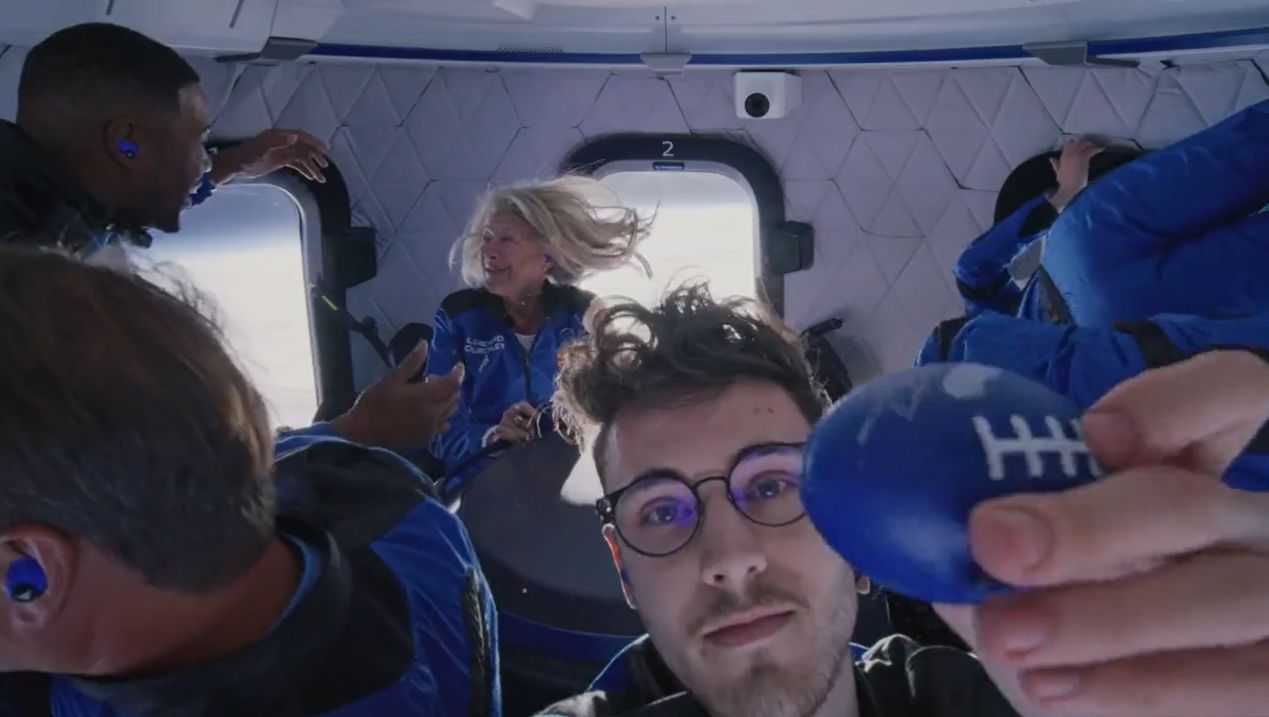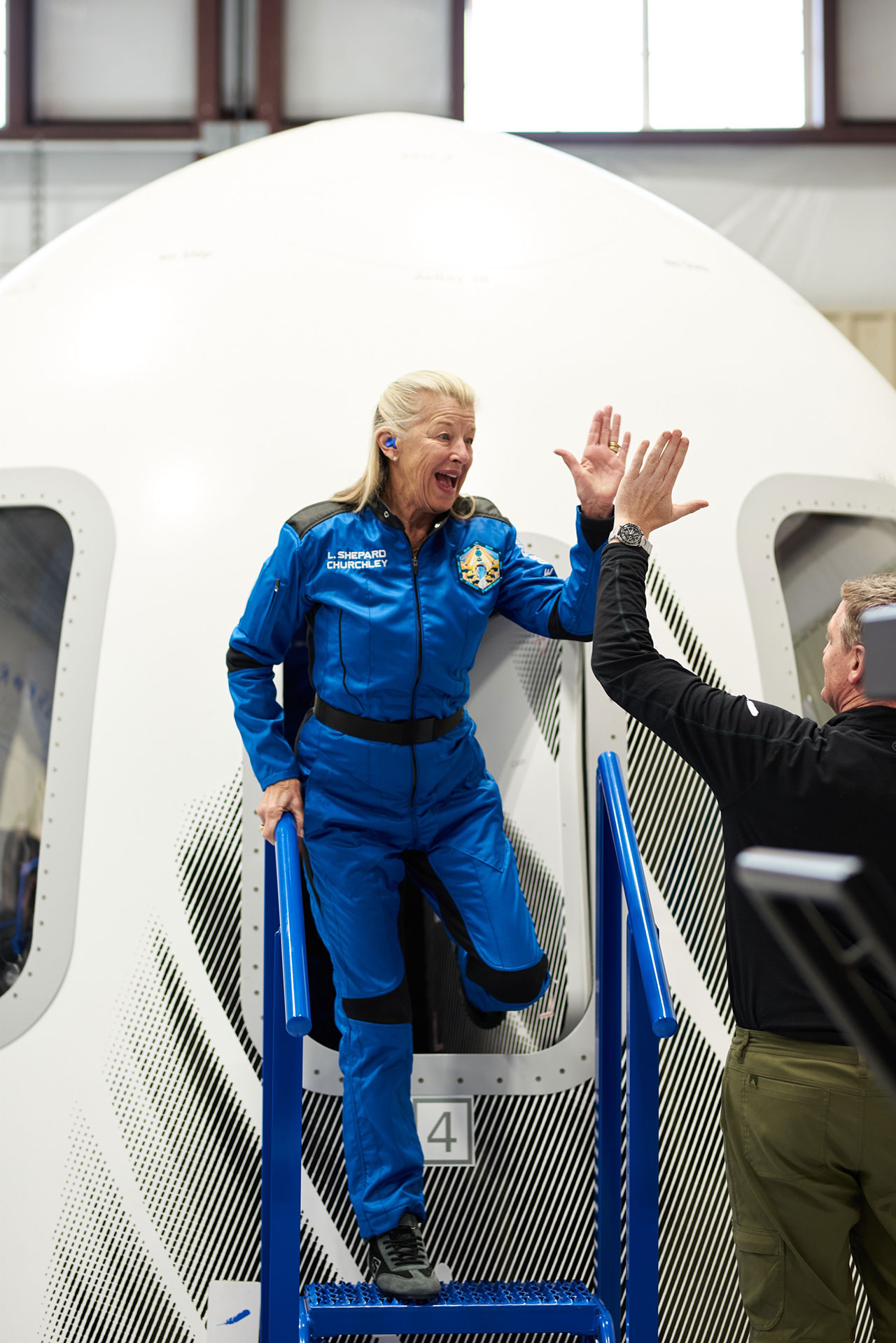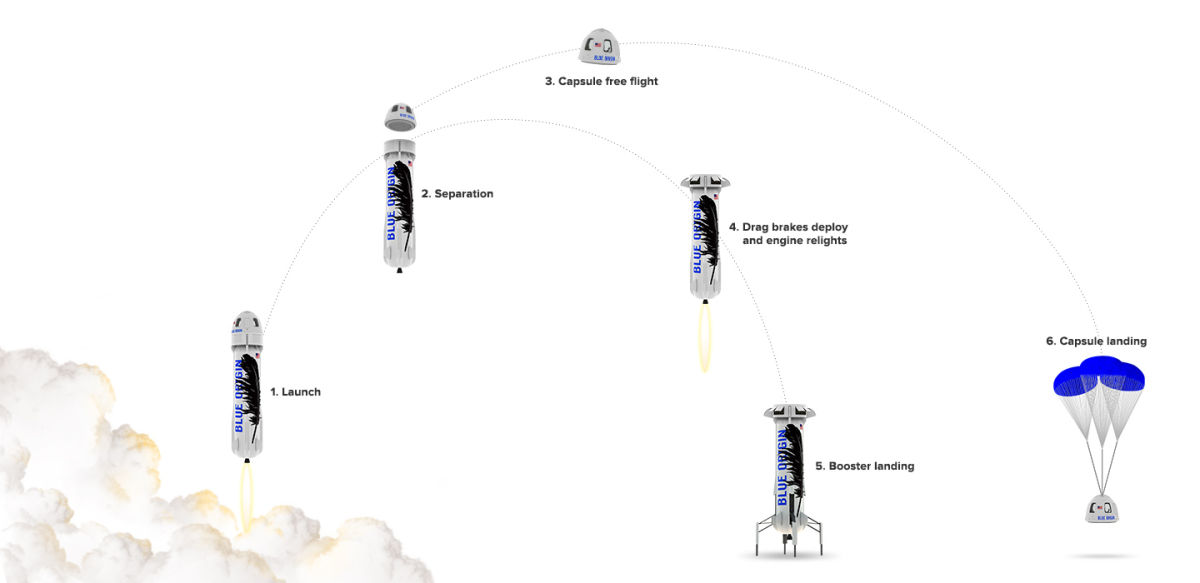Blue Origin's NS-20 space tourism launch: When to watch and what to know
The launch is scheduled for March 31 at 9:30 a.m. EDT (1330 GMT).

Update for March 28: Blue Origin has delayed the planned launch of the NS-20 mission to Thursday (March 31) at 9:30 a.m. EDT (1330 GMT), citing predicted high winds on Tuesday and Wednesday (March 29 and March 30).
Blue Origin will fly six people into suborbital space this month on the company's fourth crewed mission.
The company's New Shepard spacecraft is scheduled to lift off on March 31, carrying to the final frontier Blue Origin employee Gary Lai and five paying customers: Marty Allen, married couple Sharon Hagle and Marc Hagle, Jim Kitchen and George Nield.
Launch time for the mission — known as NS-20, because it will be the 20th flight of a New Shepard vehicle — is set for 9:30 a.m. EDT (1330 GMT) from the company's Launch Site One near Van Horn, Texas. Blue Origin will webcast the liftoff live, likely beginning about one hour before launch. You can watch it here at Space.com, courtesy of Blue Origin, or directly via the company.
Lai, the chief architect of the New Shepard system, is a replacement for "Saturday Night Live" star Pete Davidson, who had to back out of the flight after its launch date slipped from March 23 to March 29.
Here's everything you need to know about the flight.
In photos: Blue Origin's 1st New Shepard passenger launch with Jeff Bezos
Breaking space news, the latest updates on rocket launches, skywatching events and more!
What time is Blue Origin's launch and can I watch?
The launch of New Shepard's fourth crewed flight will be broadcast Thursday (March 31) with a likely start time of approximately 8:30 a.m. EDT (1230 GMT) at BlueOrigin.com and here at Space.com, if possible. Liftoff is expected at 9:30 a.m. EDT (1330 GMT), but that could change depending on weather and technical issues.
New Shepard consists of a rocket and a capsule, both of which are reusable. Each flight of the vehicle lasts about 11 minutes. Taking past webcasts as a guide, you should be able to see views of the rocket launching and landing, the capsule going into space, and potentially some footage of the spaceflyers greeting people on the ground post-flight.
As events happen, Blue Origin will likely stream them online and Space.com will simulcast if possible. The company also plans mission updates through @BlueOrigin on Twitter.
Each New Shepard flight brings its customers and guests above the 62-mile (100 kilometers) Kármán line that's generally seen as the boundary of space by international authorities. (Where outer space actually begins is a topic of some debate, however. For example, Blue Origin's chief competitor in the suborbital space tourism business, Virgin Galactic, does not quite get to the Kármán line, and the two companies have sparred about what the definition of space is.)
The flight plan calls for the rocket to land vertically shortly after liftoff and for the crew capsule to descend independently under parachutes, arriving on Earth a few minutes after the booster.
Who is Blue Origin launching on New Shepard?

New Shepard's fourth crewed mission will carry six passengers, but no pilot as the space capsule is an automated system. The crew will include:
Gary Lai, the senior director and chief architect of the New Shepard system, who joined Blue Origin in 2004 and was one of the company's first 20 employees. (Jeff Bezos founded the company in 2000.) "His prior positions include senior director of design engineering, system architect, crew capsule element lead, NASA commercial crew development program manager, lead systems engineer and pathfinding lead with responsibility for advanced research and development," Blue Origin representatives wrote in a mission description. "Gary has been involved in product development, strategic planning and business development for all Blue Origin product lines, including the New Glenn orbital launch vehicle, rocket engine programs and Blue Moon."
Lai stepped in to replace actor Pete Davidson, who had agreed to fly when the launch date was March 23 but had to back out when it slipped six days.
George Nield, current president of Commercial Space Technologies, LLC , and past holder of a variety of positions across the space industry. His resume of past work includes associate administrator for the Federal Aviation Administration Office of Commercial Space Transportation and manager of the flight integration office for NASA's space shuttle program. He also held positions at the Air Force Flight Test Center, Orbital Sciences Corp. (today, through mergers, a part of Northrop Grumman) and the U.S. Air Force Academy.
Sharon Hagle, founder of SpaceKids Global, which was established in 2015. The nonprofit aims to interest students, especially young girls, in STEAM (science, technology, engineering, arts and mathematics). Among its various activities, SpaceKids Global flies postcards to space via Blue Origin's nonprofit organization Club for the Future.
Marc Hagle, husband of Sharon and president and CEO of a property development corporation, Tricor International. The company has developed and owned more than 17.4 million square feet (1.6 million square meters) of properties across numerous sectors, according to Blue Origin's mission description. The Hagles are philanthropists for several charities in the arts, sciences, health and education. Incidentally, back in 2013 they were reported to be early purchasers of Virgin Galactic tickets, according to USA Today; it's unclear if they still plan a future flight with that company.
Marty Allen, an angel investor and CEO of multiple companies. He oversaw Party America's bankruptcy restructuring and helped change it to a nationwide retailer. He also led California Closet Company, a home organization firm, to high sales and profits.
Jim Kitchen, an entrepreneur and faculty member of the University of North Carolina’s Kenan-Flagler Business School. He is said to have been inspired by watching the Apollo program's rocket launches in Florida as a child. He also promoted low Earth orbit space transportation for an unnamed startup in the 1980s and has visited all 193 countries recognized by the United Nations, according to the Blue Origin mission description.
What will happen on the flight?
This will be New Shepard's 20th flight overall, so the current mission is called NS-20. Most of the previous flights were uncrewed tests or payload research flights.
The most recent New Shepard flight was on Dec. 11, when six people were rocketed to suborbital space; the big-name guest then was "Good Morning America" host and former NFL star Michael Strahan. Blue Origin flew two other crewed missions in 2021, sending four people into space (including Bezos) on July 20 and another foursome (including "Star Trek" captain William Shatner) on Oct. 13.
New Shepard is named after Mercury astronaut Alan Shepard, the first American to reach space on May 5, 1961. (His daughter, Laura Shepard Churchley, flew on the Oct. 13 New Shepard flight.)
New Shepard passengers are "weightless" in suborbital space for about three minutes during each mission. Blue Origin has not yet disclosed seat pricing to the public; competitor Virgin Galactic is currently selling seats for $450,000 each.
Infographic: How Blue Origin's New Shepard rocket works
Each New Shepard mission lasts roughly 11 minutes from launch to capsule landing. As the spacecraft and rocket are autonomous, no pilots are flown on board. The rocket is aerodynamically stabilized using a ring and wedge fins to help it make a soft landing. The crew comes down independently in their capsule, under a parachute.
In broadcasts and other communications, Blue Origin often mentions the spacecraft's "big, beautiful windows," its efforts to "build the road to space" and its flight altitude as marketing tools to attract customers. The company also is trying to attract more research experiments on crewed and uncrewed flights.
What will Blue Origin astronauts experience?

Based on past missions, most Blue Origin passengers receive about 14 hours of preflight training over a few days, covering basic flight and emergency procedures. (A NASA astronaut, by contrast, typically has 2.5 years of basic training before being qualified for flights, and then at least another two years of training for an International Space Station mission.)
Blue Origin crewmembers wear Blue Origin jumpsuits rather than bulky spacesuits. The aim is to make it easier for folks to move around during weightlessness and admire the view.
A Blue Origin seat auction in 2021 featured a terms and conditions document for potential passengers. It outlined several requirements, including being able to don flight suits on your own and to ascend seven flights of stairs on the launch tower in less than 90 seconds. Such activities aren't too taxing, for Blue Origin has flown two elderly people into space already: "Star Trek" star William Shatner (90 at the age of his flight) and "Mercury 13" aviator Wally Funk (then 82.)

Suborbital spaceflights are less energetic and less dangerous than orbital missions, but risks come with any trip to the final frontier. Passengers need to be prepared for potential issues such as cabin depressurization or fire. They also must endure multiple forces of gravity (G-loads) during launch and landing. In case of emergency, the crew is trained to unstrap themselves in 15 seconds.
In late September 2021, a group of 21 past and current Blue Origin employees (nearly all of them anonymous) wrote an essay criticizing the culture and safety practices at the company. They alleged that Blue Origin was seeking to launch swiftly to gain paying passengers and not paying enough attention to safety practices.
Two weeks later, Blue Origin's vice president of mission and flight operations, Audrey Powers, flew to space successfully on New Shepard on the same flight as William Shatner. Moreover, the company points to its successful track record: New Shepard has flown 19 times since 2015. The company successfully recovered the capsule and booster on every flight except the first one, NS-1.
Blue Origin uses its RSS First Step (RSS is short for Reusable Space Ship) for crewed flights. A different New Shepard capsule, called RSS H.G. Wells, is used for uncrewed science flights.
Where does Blue Origin launch New Shepard from?
Blue Origin's West Texas desert facility is remote and usually closed to the public. It is roughly 25 miles (40 kilometers) from the town of Van Horn.
The facility is called Launch Site One, and generally, only Blue Origin employees, the company's customers and a few media get to see it up close. You can, however, view the facilities in a short tour video that Blue Origin previously released. If you pay for a flight, you will receive a tour of the support facilities and the spacecraft, the video says.
When could I launch to space with Blue Origin?

While you can sign up for future flights on the Blue Origin website , its schedule and pricing are not publicly available. Given that the company started launching people just last year, it probably has a backlog of customers. It also typically reserves one of the six spacecraft seats for a media "star" — like Shatner, Strahan and Davidson — who will attract coverage of the mission.
As for the competition: Virgin Galactic flights retail for $450,000 apiece. Two other companies, World View and Space Perspective, are developing balloon-based systems to take people on leisurely trips to the stratosphere, for $50,000 and $125,0000 per seat, respectively. Both of those companies aim to begin commercial operations in the mid-2020s.
Follow Elizabeth Howell on Twitter @howellspace. Follow us on Twitter @Spacedotcom or on Facebook.

Elizabeth Howell (she/her), Ph.D., was a staff writer in the spaceflight channel between 2022 and 2024 specializing in Canadian space news. She was contributing writer for Space.com for 10 years from 2012 to 2024. Elizabeth's reporting includes multiple exclusives with the White House, leading world coverage about a lost-and-found space tomato on the International Space Station, witnessing five human spaceflight launches on two continents, flying parabolic, working inside a spacesuit, and participating in a simulated Mars mission. Her latest book, "Why Am I Taller?" (ECW Press, 2022) is co-written with astronaut Dave Williams.

